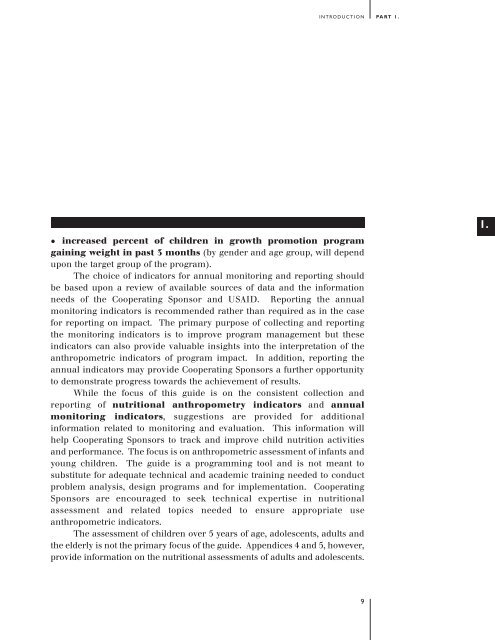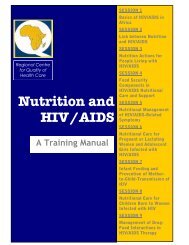2.1: Anthropometric Indicators Measurement Guide - Linkages Project
2.1: Anthropometric Indicators Measurement Guide - Linkages Project
2.1: Anthropometric Indicators Measurement Guide - Linkages Project
You also want an ePaper? Increase the reach of your titles
YUMPU automatically turns print PDFs into web optimized ePapers that Google loves.
INTRODUCTION PART 1.<br />
• increased percent of children in growth promotion program<br />
gaining weight in past 3 months (by gender and age group, will depend<br />
upon the target group of the program).<br />
The choice of indicators for annual monitoring and reporting should<br />
be based upon a review of available sources of data and the information<br />
needs of the Cooperating Sponsor and USAID. Reporting the annual<br />
monitoring indicators is recommended rather than required as in the case<br />
for reporting on impact. The primary purpose of collecting and reporting<br />
the monitoring indicators is to improve program management but these<br />
indicators can also provide valuable insights into the interpretation of the<br />
anthropometric indicators of program impact. In addition, reporting the<br />
annual indicators may provide Cooperating Sponsors a further opportunity<br />
to demonstrate progress towards the achievement of results.<br />
While the focus of this guide is on the consistent collection and<br />
reporting of nutritional anthropometry indicators and annual<br />
monitoring indicators, suggestions are provided for additional<br />
information related to monitoring and evaluation. This information will<br />
help Cooperating Sponsors to track and improve child nutrition activities<br />
and performance. The focus is on anthropometric assessment of infants and<br />
young children. The guide is a programming tool and is not meant to<br />
substitute for adequate technical and academic training needed to conduct<br />
problem analysis, design programs and for implementation. Cooperating<br />
Sponsors are encouraged to seek technical expertise in nutritional<br />
assessment and related topics needed to ensure appropriate use<br />
anthropometric indicators.<br />
The assessment of children over 5 years of age, adolescents, adults and<br />
the elderly is not the primary focus of the guide. Appendices 4 and 5, however,<br />
provide information on the nutritional assessments of adults and adolescents.<br />
1.<br />
9

















